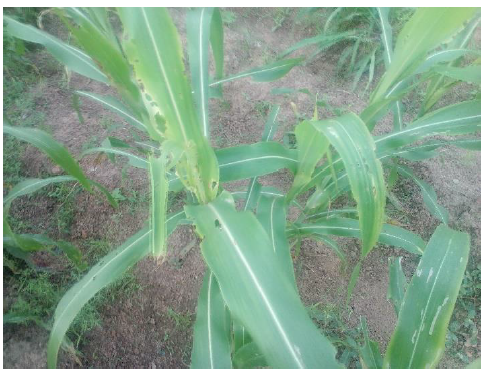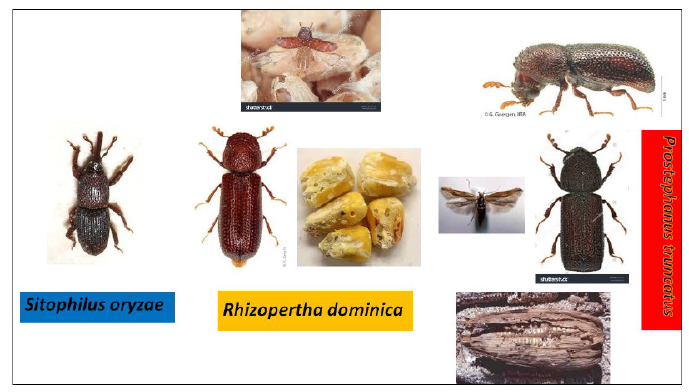 Short Communication
Short Communication
Integrated Management of Maize Pests in Vegetation and in Storage
BELLO Saliou1*, GANDAHO Pie Savaie2 and DJIHINTO Cocou Angelo3
1Maize Research Program/CRA-Sud/INRAB, Agricultural Research Center of South Benin, National Agricultural Research Institute of Benin, PO Box 03 Attogon,Allada, Republic of Benin
2Enzymatic and Food Engineering Research Unit (URGEA), Applied Chemistry Study and Research Laboratory (LERCA), Polytechnic School of Abomey-Calavi (EPAC), University of Abomey-Calavi ( UAC), 07 BP 0235, Cotonou, Republic of Benin
3Scientific Animation Service (SAS) of the Scientific Directorate of the National Institute of Agricultural Research of Benin (INRAB), 01 Po Box 884, Cotonou,Republic of Benin
BELLO Saliou, Maize Research Program/CRA-Sud/ INRAB, Agricultural Research Center of South Benin, National Agricultural Research Institute of Benin, PO Box 03 Attogon, Allada, Republic of Benin
Received Date: October 31, 2022; Published Date: November 30, 2022
Abstract
Keywords: Cereal; Control; Insect pest; Loss; Poverty reduction
Short Communication
In Benin, the agricultural sector contributes 32% of the Gross Domestic Product (GDP), 88% of export earnings and employs about 70% of the working population. However, the presence of insect pests of corn, which are in particular the vegetation pest, defoliator and stem borer, Spodoptera frugiperda (Figures 1 and 2), and the weevils Prostephanus truncatus, also called the large corn borer, Sitophilus zeamaïs, Sitophlus oryzae and Rhizopertha dominica (Figure 3), in stocks of maize grains lead to quantitative and qualitative losses. This situation reduces the livelihood capacity and income of producers, processors and consumers. The diversification of a range of effective insecticides to circumvent the resistance of certain insect pests dependent on corn in vegetation and in storage, to certain molecules, has led research and the plant protection service to formulate recommendations for products approved for Benin by the National Committee for the Approval and Control of Phytopharmaceutical Products (CNAC) [1]. To better protect vegetation, store and preserve maize grains in storage, different control methods, in this case chemical control and physical control, are commonly proposed and adopted by most cereal producers, traders and consumers. Based on the results of research work and documentary research with practitioners, a technical sheet has been drawn up to trace current practices and propose attitudes to adopt to better reduce vegetation and post-harvest losses [2]. The factors determining the attacks include (i) the type of insect and place of infestation, (ii) the state of drying of the grains, (iii) the state and storage conditions of the grains before harvesting, in particular with respect to grain maturity, ear cover, storage site and conditions, and timing of harvest, (iv) post-harvest condition and storage conditions of grain, including concerns the variety and quality of the product stored (relative humidity of the grains, degree of maturation), the forms of storage, the climatic factors depending on the site and the season: temperature and humidity, the water content of the grain, condition of store, type of store/storage, maintenance and duration, insect diversity (pests, natural enemies, population dynamics) and pre-harvest infestation, (iv) forms of storage with regard to shelled form, cob with or without husks, temperature and humidity grain moisture content, (v) type and condition of storage, (vi) level of infestation before harvest. Different control methods including chemical control, physical control, drying, the use of insect repellent sheets and several bagging techniques are documented and proposed to effectively control pests in vegetation and in storage [3,4]. However, only the use of chemical products makes it possible to effectively control insects in vegetation and in stock for a maximum period of one (01) year, of course also, that the population of S. zeamais must be controlled by an insecticide. of synthesis for a better conservation of corn in storage. The use of Sofagrain insecticides based on pirimiphos-methyl (16 g/kg) and permethrin (3 g/kg) or pyrimiphos- methyl (1.5%) and deltamethrin (0.1%), and Actellic Gold Dust DP, a binary insecticide based on pyrimiphos-methyl at the content of 16 g/kg and Thiamethoxam 3.6 g/kg are recommended. The adoption of good practices combined and coupled with vigilance and attitudes of control and monitoring, makes it possible to reduce at best, the losses in vegetation and post-harvest, in order to ensure self-sufficiency and food security, as well as poverty reduction [5].
Figure 1: Leaf damage from the armyworm, Spodoptera frugiperda, on a maize plant in the field.

Figure 2: Maize armyworm, Spodoptera frugiperda, damages on cob.

Figure 3: Insects of maize stocks of major importance with illustrations of their negative impacts in terms of qualitative and quantitative damages.

Acknowledgement
None.
Conflict of Interest
There is no conflict of interest.
References
- Bello S (2004) Proposals for control practices in a real environment, post-harvest insects in relation to their biology: Case of Sitophilus zeamaïs, Rhizopertha dominica and Sitotroga cerealella, in stocks of cereal agricultural products maize, rice, sorghum and millet, and of cassava and yam roots and tubers. Presentation presentations to the Diploma of Advanced Studies (DEA) in Plant Genetic Resources and Crop Protection (RPGPC), FSA/UAC, 35 p.
- Bello S (2021) Training modules for producers and technicians in sustainable land management and integrated pest management for optimal maize production. Project PAIRED/CORAF/USAID, Bohicon, Mai 2021, Modules PWPT, 32 p.
- Gandaho PS, FP Tchobo, S Bello (2016) Maize and sorghum storage and preservation practices adopted in northeast Benin. Benin Agricultural Research Bulletin (BRAB). 1840-7099, Pages (pp.) 43-53.
- Hounsou CM, DY Arodokoun, R Sikirou, ET Zannou, S Bello, et al. (2015) Efficacy of Actellic Gold Dust DP, a binary insecticide based on the efficacy of pyrimiphos–methyl and thiamethoxam, for the control of Sitophilus zeamais in maize stocks in Benin. Annals of Agricultural Sciences 19(2): 69-80.
- Sikirou R, DY Arodokoun, S Bello, CM Hounsou, ET Zannou, et al. (2015) Evaluation of the efficacy of Protect DP, a binary insecticide based on pyrimiphos-methyl and deltamethrin, for the control of the weevil, Sitophilus zeamais in corn stocks in Benin, Annales des Sciences Agronomiques 19(2): 187-200.
-
BELLO Saliou*, GANDAHO Pie Savaie and DJIHINTO Cocou Angelo. Integrated Management of Maize Pests in Vegetation and in Storage. World J Agri & Soil Sci. 8(3): 2022. WJASS.MS.ID.000689.
-
Cereal, Control, Insect pest, Loss, Poverty reduction
-

This work is licensed under a Creative Commons Attribution-NonCommercial 4.0 International License.






